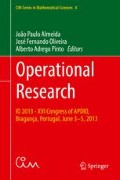Abstract
Inventory management plays an important role in supply chains. Through a correct inventory management policy, supply chains can close the gap created by the imbalance between supply and demand, eliminating costly supply chains. This paper aims to contribute to this goal and presents an Inventory Management (IM) policy implemented on a Mixed Integer Linear Programming (MILP) model that optimizes the flow of products through a multi-period and multi-product supply chain. Normally distributed demands are received at the retailers who replenish their stock from the regional warehouses, which, in turn, are supplied by a central warehouse. Lateral transshipment is allowed among regional warehouses and among retailers. In order to validate and compare the proposed policy against commonly used policies, the Continuous Review and the Periodic Review policies are modeled using the same approach and acting over the same system. The comparison of inventory management policies shows that the IM policy outperforms the classical policies in terms of material availability leading to an overall reduction of operational costs.
Access this chapter
Tax calculation will be finalised at checkout
Purchases are for personal use only
References
Abdul-Jalbar, B., Gutiérrez, J., Sicilia, J.: Single cycle policies for the one-warehouse N-retailer inventory/distribution system. OMEGA Int. J. Manag. Sci. 34, 196–208 (2006)
Axsater, S.: Approximate optimization of a two-level distribution inventory system. Int. J. Prod. Econ. 81, 545–553 (2003)
Beamon, B.M.: Supply chain design and analysis: models and methods. Int. J. Prod. Econ. 55, 281–294 (1998)
Giannoccaro, I., Pontrandolfo, P.: Inventory management in supply chains: a reinforcement learning approach. Int. J. Prod. Econ. 78, 153–161 (2002)
Hsiao, Y.-C.: Optimal single-cycle policies for the one-warehouse multi-retailer inventory/distribution system. Int. J. Prod. Econ. 114, 219–229 (2008)
Krautter, J.: Inventory theory: new perspectives for cooperative management. Int. J. Prod. Econ. 59, 129–134 (1999)
Monthatipkul, C., Yenradee, P.: Inventory/distribution control system in a one-warehouse/multi-retailer supply chain. Int. J. Prod. Econ. 114, 119–133 (2008)
Ozdemir, D., Yucesan, E., Herer, Y.: Multi-location transshipment problem with capacitated transportation. Eur. J. Oper. Res. 175, 602–621 (2006)
Paterson, C., Kiesmuller, G., Teunter, R., Glazebrook, K.: Inventory models with lateral transshipments: a review. Eur. J. Oper. Res. 210, 125–136 (2011)
Yousuk, R., Luong, H.T.: Modeling a two-retailer inventory system with preventive lateral transshipment using expected path approach. Eur. J. Ind. Eng. 7, 248–274 (2013)
Author information
Authors and Affiliations
Corresponding author
Editor information
Editors and Affiliations
Appendix: Experimental Results Regarding to Computational Statistics
Appendix: Experimental Results Regarding to Computational Statistics
In this Appendix, we show the computational statistics of the inventory management case study.
1.1 A1. Initial Inventory as a Parameter Given by the Portuguese Company
The computational statistics for all three inventory policies are shown in Table 13. Regarding to computational time used, the IM model has the highest one, since all decisions are taken by the optimization model.
Computational statistics for CR policy for three different reference stock levels are shown in Table 14. Regarding to the computational time used, its increases with the reference stock level increase, but the required equations and variables maintain the same value.
Computational statistics for PR policy for three different review periods is present in Table 15. The results show that the number of equations and variables decreases with the increase of the review period while computational time used decreases. This behavior is expected, since with less revisions, less constraints and variables are required.
1.2 A2. Initial Inventory as an Optimization Variable
Computational statistics for all three inventory policies is present in Table 16. For IM policy we have 1.28 % of relative gap after one hour of computation, but we already reached the lower total costs among all policies. The complexity of the IM model is expected, since all decisions are taken by the optimization model.
Table 17 shows the computational statistics for CR policy for three different reference stock levels. The computational time used increase with the reference stock increase, but the equations and variables maintain the same value.
Computational statistics for PR policy for three different period review in Table 18, shows that single equations and variables decrease with the period review increase, while computational time used decrease.
Rights and permissions
Copyright information
© 2015 Springer International Publishing Switzerland
About this paper
Cite this paper
Vicente, J.J., Relvas, S., Barbosa Póvoa, A.P. (2015). Multi-period and Multi-product Inventory Management Model with Lateral Transshipments. In: Almeida, J., Oliveira, J., Pinto, A. (eds) Operational Research. CIM Series in Mathematical Sciences, vol 4. Springer, Cham. https://doi.org/10.1007/978-3-319-20328-7_23
Download citation
DOI: https://doi.org/10.1007/978-3-319-20328-7_23
Publisher Name: Springer, Cham
Print ISBN: 978-3-319-20327-0
Online ISBN: 978-3-319-20328-7
eBook Packages: Mathematics and StatisticsMathematics and Statistics (R0)

